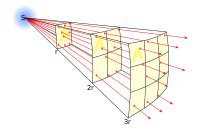
Photo from wikipedia
Variations in redshift measurements of Type 1a supernovae and intensity observations from large sky surveys are an indicator of a component of acceleration in the rate of expansion of space-time.… Click to show full abstract
Variations in redshift measurements of Type 1a supernovae and intensity observations from large sky surveys are an indicator of a component of acceleration in the rate of expansion of space-time. A key factor in the measurements is the intensity-distance relation for Maxwell’s equations in Friedmann-Robertson-Walker (FRW) space-times. In view of future measurements of the decay of other fields on astronomical time and spatial scales, we determine the asymptotic behavior of the intensity-distance relationship for the solution of the wave equation in space-times with an FRW metric. This builds on previous work done on initial value problems for the wave equation in FRW space-time [Abbasi, B. and Craig, W., Proc. R. Soc. London, Ser. A 470, 20140361 (2014)]. In this paper, we focus on the precise intensity decay rates of the special cases for curvature k = 0 and k = −1, as well as giving a general derivation of the wave solution for −∞ 0} where t0 represents the time of an initial emission source, relative to the Big Bang singularity at t = 0. The initial data [g(x), h(x)] are assumed to be compactly supported; supp(g, h) ⊆ BR(0) and terms in the expression for the fundamental solution for the wave equation with the slowest decay rate are retained. The intensities calculated for coordinate time {t : t > 0} contain correction terms proportional to the ratio of t0 and the time differences ρ = t − t0. For the case of general curvature k, these expressions for the intensity reduce by scaling to the same form as for k = −1, from which we deduce the general formula. We note that for typical astronomical events such as Type 1a supernovae, the first order correction term for all curvatures −∞ 0} where t0 repres...
Journal Title: Journal of Mathematical Physics
Year Published: 2018
Link to full text (if available)
Share on Social Media: Sign Up to like & get
recommendations!